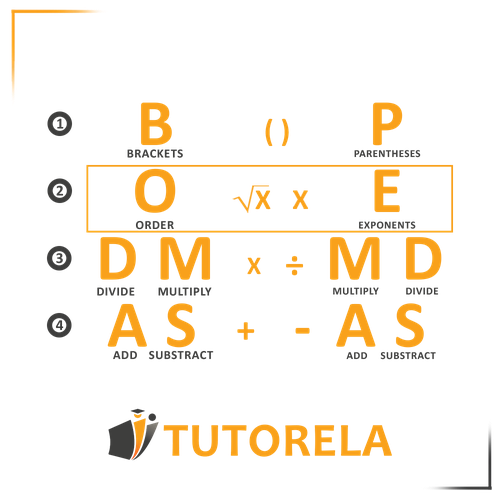The second step in the order of operations is - exponents and roots!

The second step in the order of operations is - exponents and roots!

Immediately after dealing with parentheses, we move on to exponents and roots!
Pay attention - even within parentheses, it's very important to maintain the correct order of operations!
Exponent - multiply the base by itself the number of times shown in the exponent (the small number on the top right).
Root - half power - which positive number when multiplied by itself will give the number written under the root.
\( 5+\sqrt{36}-1= \)
An exponent is the requirement for a number to be multiplied by itself several times.
In other words, when we see a number with a certain exponent, we know that we need to multiply the number by itself several times to get the actual number.
The base of the exponent will be the number itself and the exponent will be the power number - the small one on the top right.
For example:
The number is raised to the power of so we need to multiply the number by itself times. We get:
Remember - when a number is raised to the power of = the result will always be .
A root equals to the power of
The result of a root will always be positive or and never negative.
When we encounter a root of a number, it's like asking ourselves - which number raised to the power of would give us the number inside the root.
For example:
When we see the root of we ask ourselves, which number squared equals ?
The answer is .
Root of a product
Square root of a quotient
\( 7 + \sqrt{49} - 5 = \)
\( 3 \times 2 + \sqrt{81} = \)
\( 8 - \sqrt{16} \times 3 = \)
When it comes to order of operations, right after parentheses we deal with exponents and roots in the expression!
The truth is? It doesn't matter if we start from left to right. At this stage of handling exponents and roots, we are only changing the expression cosmetically, and as long as we deal with all exponents and roots, their order doesn't matter.
Let's practice:
Here is an exercise –
Solution:
We learned that the first operation in the order of operations is dealing with parentheses, so we'll handle the parentheses first.
Notice that inside the parentheses there are numbers with exponents, so we'll solve them first –
Let's write the results we got inside the parentheses in the original expression and we get:
Let's continue solving –
Notice, have we finished dealing with parentheses? Not really. We'll solve the expression inside the parentheses and only then can we continue with the other numbers.
Let's solve the expression inside the parentheses:
And now let's write the original expression without parentheses:
Now let's continue solving – the next step is solving exponents and roots.
Let's write the results in the original expression and we get:
Now this is a really easy expression to solve. Let's solve it and we get:
Let's practice another exercise!
Solution:
We know this exercise is a bit long... but don't worry. Let's solve it slowly, step by step:
Let's start with the first step in order of operations - parentheses!
The first parentheses from left to right are:
We know that the next step right after is exponents and roots, so we'll deal with the exponent inside the parentheses:
Now we'll solve the multiplication and then the subtraction and get:
We'll write the result in the original exercise and continue:
Let's move to the second parentheses:
Let's deal with the square root
And we get:
Let's write the result in the original exercise and continue solving.
Now let's continue solving the parentheses:
Let's write the results in the parentheses and solve:
Great! Now let's write the result in the original exercise instead of the parentheses and we get:
Now that we've gotten rid of all parentheses, roots, and exponents, let's continue to the third step - multiplication and division from left to right:
Let's write the result in the original exercise:
We're done with multiplication and division and can move on to addition and subtraction from left to right. We get:
The result is !
\( 10-5^2:5= \)
\( 15-4^2:2= \)
\( 20-3^3:3= \)
First, compute the power: .
Next, divide: .
Finally, subtract: .
First, compute the power: .
Next, divide: .
Finally, subtract: .
First, compute the power: .
Next, divide: .
Finally, subtract: .
First, evaluate the square root: .
Then, follow the order of operations (PEMDAS/BODMAS):
1. Multiplication:
2. Subtraction:
So, the correct answer is .
First, evaluate the square root: .
Then, follow the order of operations (PEMDAS/BODMAS):
1. Addition:
2. Subtraction:
So, the correct answer is .